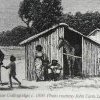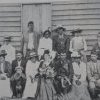1890s
1890
16 Koories sign a petition asking for land: “We, the native blacks about Sydney, ask you if you would be kind enough to give us a piece of land at Jervis Bay, where we can make a home for ourselves and our people. We have been hunted about a good deal from one place to another, and we find it hard to get a living for ourselves and our children, but if we get a chance and some help from the government, we might in time get a living. As it is we find it very hard. Drink and a hard life are killing us off. White people ought to be very good to us for they got our good country for nothing. We don’t want them to pay us for it, but they ought to help us to live. We would like our boys and girls to learn to read and write like white children and we want boats and nets for fishing, so we can get money for our work and learn to live like Christians.” Goodall, Invasion to Embassy, pp. 82-83.
1891
1892
1893
Lucy Leane demands recognition of her right as a Koori woman to land and an economic future. She calls herself, in accurately, the ‘only Surviving Woman of the Georges River’, and in a petition to the government asks for a fishing boat ‘for the purposes of carrying on trade on the Georges River’ She was refused. Goodall and Cadzow, Rivers and Resilience, p 75-77
Lucy Leane, married to William Leane, having raised 13 children has with her husband developed at 33ha farm and vineyard. She writes to the Aborigines Protection Board this petition: “Your Petitioner … is the only surviving Native Woman of the Georgian River and Liverpool District residing here ever since her birth, 53 years ago. “Being a bona fide Original Native of Australia & of this District your Petitioner requests of you the supply of a boat as granted by Government in all such cases, for the purpose of carrying on trade on the Georges River.” Goodall and Cadzow, Rivers and Resilience, 77. Although the Board rejects her claim the Leanes continue their occupation in the family name until at least 1925. Goodall and Cadzow, Rivers and Resilience, 77-78












